Contribute
In “Invisible String”, I (Xiaozhuang Gao) was responsible for the programming techniques and visual design of part 2, as well as taking on the role of coordinating the team. I needed to make creative decisions regarding the core concepts and forms of the performance, in order to drive the project forward and unify team members’ ideas. Therefore, in this reflection, I will introduce the work I did in the group and what I learned in this course.
Reflection- technology support
Firstly, in the early stages of the project, I was responsible for the programming part of Processing and Kinect. After Submission1, as we believed that Part1 of the performance had already involved abstract particle graphics, we wanted to control the growth speed of the particles through sound interaction. Based on this idea, I began to write the particle code, and the initial particle generation was designed in Touch designer. As I had prior experience using Touch designer, I believed that it was a great software for sound and visual interaction, and that we could control particle changes through functions such as Life Expect, Drag, and Life Variance.
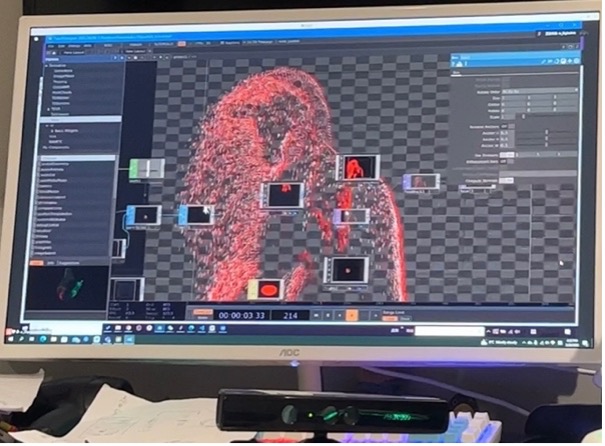
Fig 1. First particle testing on TD
During the technical implementation, I found that the particles in Touch Designer were essentially composed of individual pixels and could not be resized to the expected size. Therefore, I switched to using Processing to achieve the particle effect.
As the project progressed, we decided to combine the Processing particle section with Kinect motion capture for Part 2 of the performance instead of Part 1. After discussing with my teammates, I believed that the figure captured by Kinect V2 should be trapped in an invisible space, metaphorically representing the cage formed by a mother’s expectations for her children. Therefore, when drawing the graphics, I utilized the built-in P3D mode in Processing, adding a parameter for depth. To set different origins and rotations for different objects, I used the pair of matrix statements pushMatrix() and popMatrix(). With these commands, I was able to create 3D graphics while maintaining the rotation of the cube. I used the code instruction rotateY(-sin(frameCountspeedR)); rotateX(-cos(frameCountspeedR)); to control the rotation speed on the X and Y axes, thereby expressing the concept of the daughter being trapped in bondage and unable to escape. (fig2.Coding)

Fig2.Coding
And, based on the concept of “confinement”, I came up with an idea: Can we calculate the position of the vertices of the cube to prevent the particles from escaping during diffusion? After testing, I found that because the cube is constantly rotating randomly, it is impossible to calculate the exact vertices, which also means that the particles cannot be completely confined within the cube. However, after consulting tutorials, I adopted a compromise by controlling the left and right, and top and bottom boundaries of particle movement. Additionally, while testing the kinect, I attempted to test the movement of particles in a 3D environment but found that the effect was not satisfactory, so I did not enable the Z-axis depth value.
In fact, there are still many areas for improvement in the visual code presentation of Part 2. For example, on March 27th, 2023, during a tutorial, the instructor pointed out that the visual richness of Part 2’s particle display was somewhat disconnected from Part 1’s key imagery. Although I eventually changed the background cube to red, the problem still persisted. In my opinion, in future project development, the color of the particles could reflect the color of the clothing captured by the Kinect, rather than just being white.
At the same time, because of the interaction with sound, the speed of particle diffusion and disappearance was not well controlled, sometimes resulting in a too-scattered state. This part of the code still has room for improvement.
Reflection- Visual design
In terms of visuals, Shutong Liu and I were responsible for the visual design of the project. At the beginning of the project, our group’s visuals were monotonous and abstract. Following feedback from our submission 1 mentor, we were encouraged to increase the feedback of the visual projection. Drawing from my previous experience in filming and producing key images, I suggested to the group that we use key images to showcase our visuals, and use narrative techniques to present our performance. Subsequently, I drew the storyboards for part 1 video and the video was filmed based on this. Meanwhile, our group discussed many versions of the performance venue layout, and I combined the opinions of the group members to design the performance venue (Fig3. Performance venue). I also designed the poster for our final performance (Fig4. poster), and our group worked together to build the line installation for part 2.
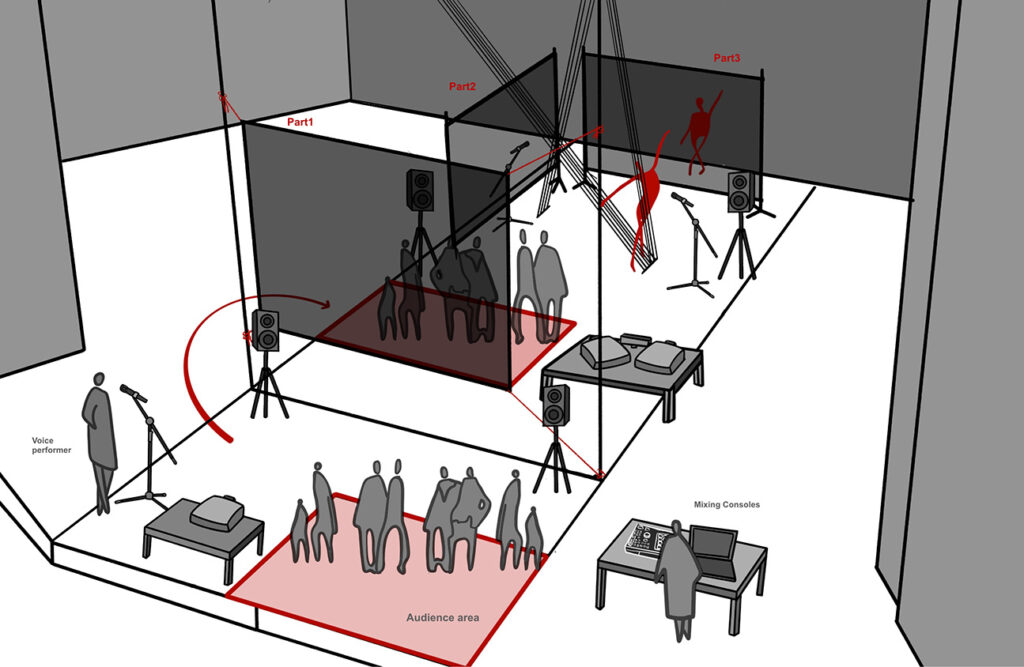
Fig3.Performance venue

Fig4. poster
In my opinion, the biggest visual challenge was the planning of the performance venue and the construction of the installation. The planning of the venue took too much time and we discarded many ideas and sketches throughout the process. Although the planning of the venue needed to consider the specific performance format, the audience, and the performance area for the performers, due to too many considerations in the early stage, we could not determine the specific performance format for each aspect. This resulted in our group wasting too much time on the visual planning of the venue, which delayed the normal progress of other aspects of the work.
Furthermore, the construction of the installation was also a challenge. We spent a lot of time trying the wrong way to fix the wires, which resulted in all the wires getting tangled together the day before the performance. We had to start over and use a different approach. If we had discovered the flaw in the wire-fixing method earlier, we would have had more time to create the visual installation.(Fig5. Installation processing)
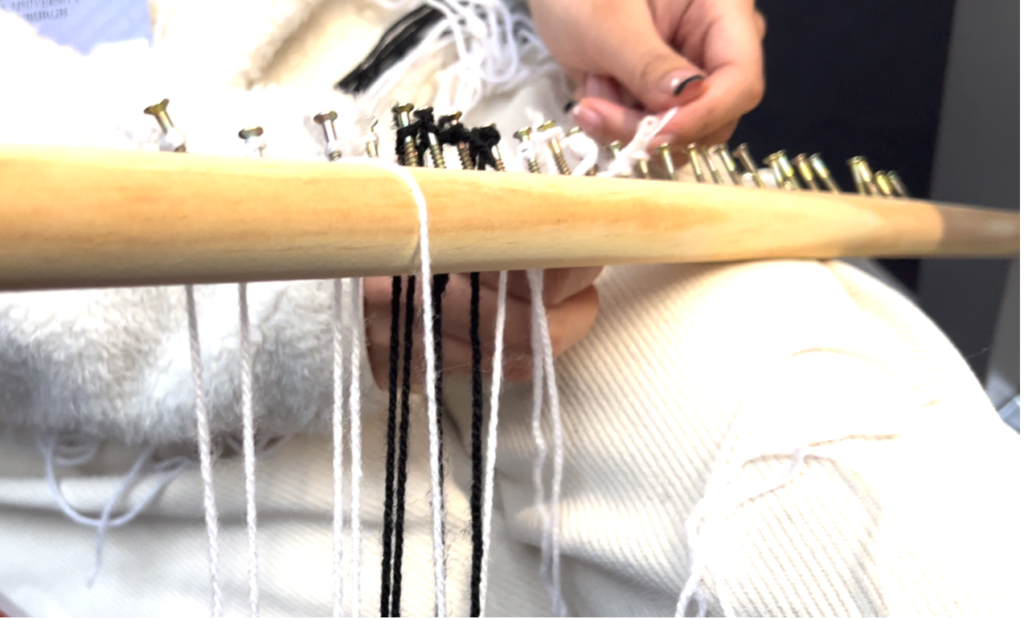 Fig5. Installation processing
Fig5. Installation processing
Reflection-Group coordination
Finally, I also served as the overall coordinator within the group. For video filming, I took full responsibility for the shooting of the film (Fig6.recording), recording the process of the group’s work on the lighting arrangement at the scene and other related matters. At the same time, I was also the voice performer for the part 1 performance (Fig7.voice performer)and participated in the choreography of the dance movements for part 3.
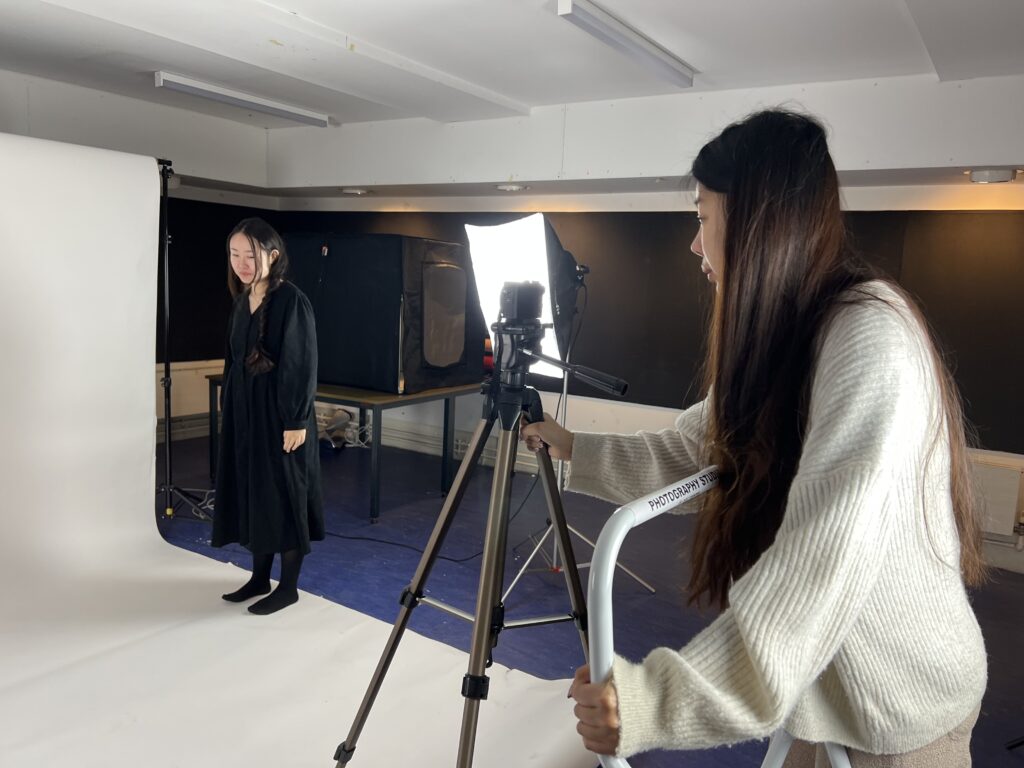
Fig6.recording
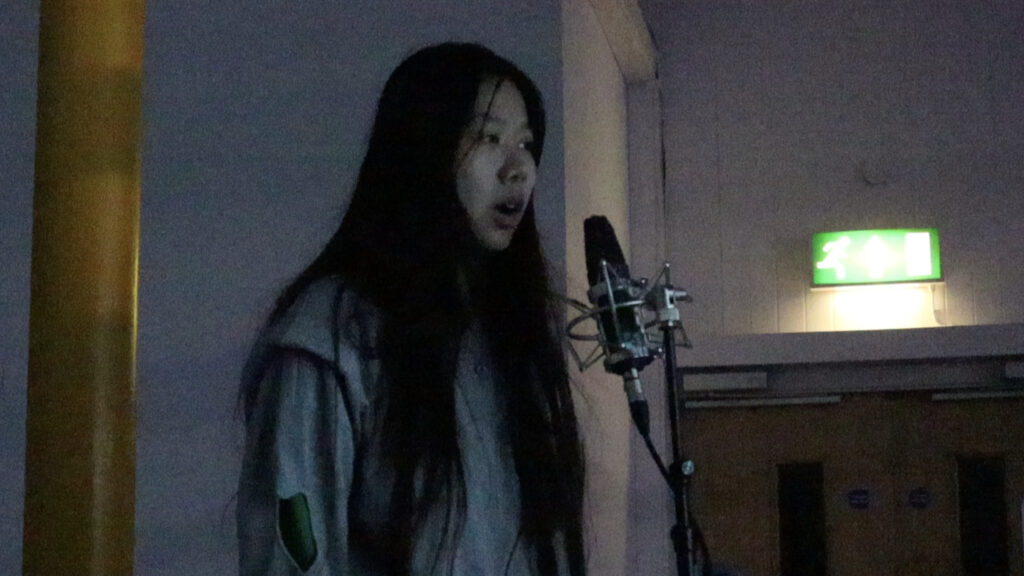
Fig7.voice performer
Conclusion
In general, this was my first time putting interactive performance into practice. Although our group consisted of only four people, we often felt that we were short-staffed. However, it was precisely because of this that our group’s work was not disjointed, and each member participated in every aspect of the work, rather than working separately. Of course, there are still many areas in our performance that need improvement, as pointed out by our mentor in the feedback given after our last formal performance. Specifically, the transitions between each stage of our performance need to be more closely linked in order to provide a better experience for the audience.
Project Source File
Part2 video
Processing
https://drive.google.com/drive/folders/1oyMpaftdqVVoR2Yg1Jd-NMoTqF9XqOA1?usp=sharing
Processing Test (Old Version)
https://drive.google.com/drive/folders/1b57YIC2tuZJ0PA9p-rgbjUhLvx3UEDa5?usp=sharing

